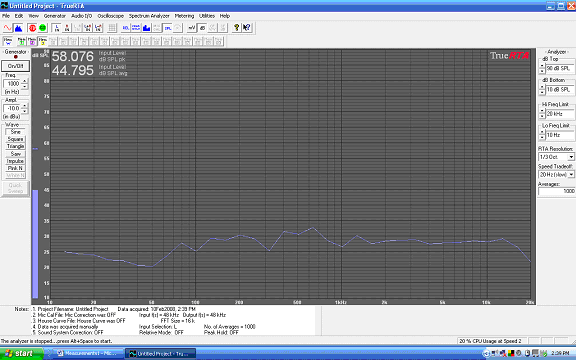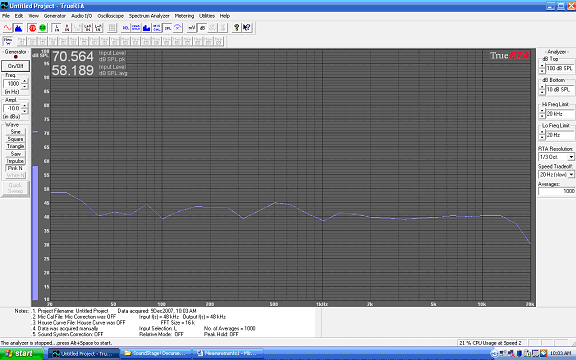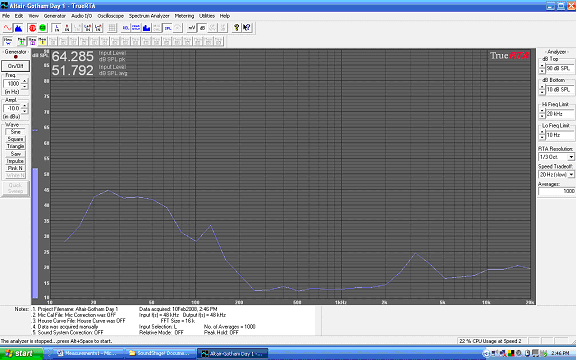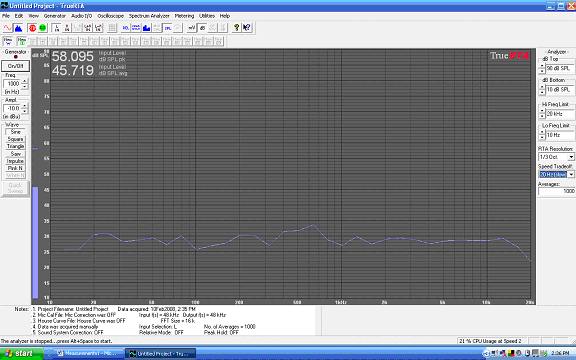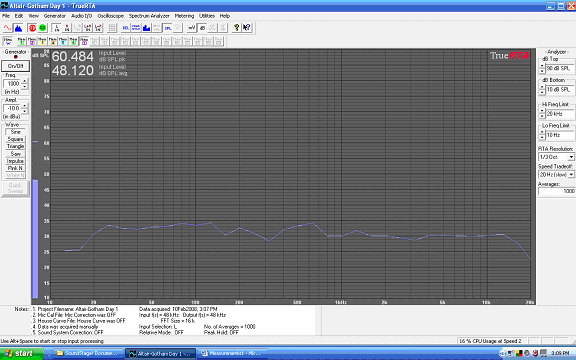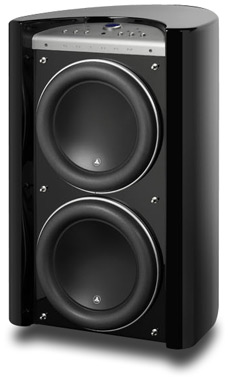 |
|||||||
| April 1, 2008
For years, the vast majority of subwoofers have been designed to reproduce the ".1" channel of a 5.1- or 7.1-channel system, and have been installed in home theaters. There have been exceptions, however. The subwoofers of yesteryear -- the Muse Model 18, the Entecs, the Kinergetics, the Hartleys -- though no longer produced, were used in some of the most ambitious high-end stereo systems of their day. Today, subwoofers are far more common, and when state-of-the-art audio systems are discussed, subs are part of the conversation. Many, if not most, high-end speaker companies -- Wilson Audio Specialties and Thiel Audio come to mind -- make subwoofers to match their most ambitious speaker models. There are also a number of subwoofer-only companies that have sprouted up to serve the high-end market. JL Audio is one of the most ambitious of these, and in this article I discuss their Gotham g213 model ($11,000 USD). Integration possibilities The biggest challenge facing the audiophile who is intent on adding a subwoofer(s) to his or her system is how to integrate it with the main speakers. It’s critical that the subwoofer’s sound be seamlessly blended with the stereo speakers’ sound so that the three (or more) enclosures essentially operate as a single unit. This can’t be stated strongly enough: the integration of subwoofer and mains makes or breaks the system’s sound. A properly installed subwoofer can be a wonderful addition, extending and smoothing the low-bass response in a way that two full-range speakers can seldom match. However, the lack of good integration -- a symptom of poor setup resulting from a lack of the necessary tools and/or knowledge -- can lead to frustration, endless tinkering, and, typically, an expensive subwoofer offered for sale on a used-equipment website. There are a number of different ways to go about integrating a subwoofer into a stereo system; in this article, I discuss what worked best for me. But before I get into that, allow me to introduce you to JL Audio’s Gotham g213. Enter the Gotham g213 Long known for producing some of the industry’s best audio gear for cars, JL Audio ventured into the home market a few years ago with their Fathom line of powered subwoofers. The Fathom f112 and f113 have earned rave reviews from our writers, but JLA was already planning something even better. Enter the Gotham g213: at 360 pounds, with twin 13.5" W7 drivers, a 3800W amplifier, a wholly fiberglass cabinet, and an impressive suite of processing and connection options, this is a subwoofer’s subwoofer. When I first saw the g213, I was immensely impressed. Inset into the curved rear of the Gotham’s gloss-black cabinet is a massive brushed-aluminum heatsink that incorporates the hookup options: dual balanced XLRs, dual single-ended RCAs, and an IEC connection for the power cord. There is also an XLR output with switch so you can slave additional Gothams to a master g213. This function allows the first sub in the chain to transmit all of its settings to the slave units so that you don’t have to individually adjust each g213. The control panel, on the top front of the cabinet for easy access, has the usual controls: a knob for adjusting the low-pass crossover (30-130Hz), a slope switch (12 or 24dB/octave), a polarity-inversion switch, a continuously variable phase knob, and a large, blue-lit, level-control knob. The power options, too, are the usual: Off, On (all the time), and Auto, which senses an incoming signal and wakes the Gotham from sleep mode. A few of the g213’s other features aren’t so usual. First is the Extreme Low Frequency (ELF) trim knob, which allows fine tuning at 25Hz (continuously variable from +3dB to -12dB). Next is a jack for the supplied microphone: Place the microphone at the listening position, connect it to the Gotham with the supplied cable, hit the button that activates JLA’s proprietary Automatic Room Optimization (ARO) software, and stand back. The Gotham then plays a series of low-frequency tones and calibrates itself to the room by flattening the most offensive peak in its frequency response. Bye-bye, boomy bass.
The Gotham’s exterior finish is a classy automotive-type gloss that comes only in black. The g213 is large but not unmanageable at 34.13"H x 21.50"W x 24"D, but at 360 pounds, it requires some wrestling to get it into place. JL Audio sent me two of them. Test equipment and experimentation Having spent many months working on integrating subwoofers into several very-high-end two-channel audio systems, I’ve become convinced that, to do this with any reasonable degree of success, you need some basic test equipment. Tuning a sub by ear while listening to music just won’t get the job done right. By its very nature, music is a collection of individual frequencies -- and that leads to unknowns. For example, if there’s a deep but narrow trough in your bass response at exactly 60Hz, the music you play while adjusting the sub’s response must have constant content at that frequency, and you must be able to identify that frequency by ear. This is next to impossible, even for the best ears out there. A better method is to look at a frequency-response graph; there, your results, including that 60Hz trough, will be instantly visible. Later, you can verify your results by ear while listening to music. This is what I do. What you need to get started: a reliable microphone (I use a relatively inexpensive Behringer ECM8000, which can be found in most local music stores) and a real-time spectrum analyzer. For the latter I use TrueRTA, a program from True Audio that’s available for a reasonable sum as a download from their website (the full-featured, Level 4 version costs $100). This setup allows me to capture extremely accurate frequency-response graphs that I have found invaluable in the calibration process. If you don’t have such a setup, get it before you buy a subwoofer. It’ll cost you only about $200, assuming you already have a computer that you can use in your listening room. When you’re ready to begin, expect to spend lots of time moving the subwoofer about, measuring its position in the room with a tape measure (explained below), measuring its acoustic response with your test setup, listening to music and pink noise, then starting all over again -- again and again. My advice is to get a buddy to help you, order a pizza, put on a pot of coffee, and settle in for a long afternoon of subwoofing. Good bass takes a while. Two subwoofers and phase I’ll begin by sharing with you a few opinions I’ve formed during the course of my subwoofing sojourn. First, you need a minimum of two subwoofers. Two, three, or four subwoofers load a room with bass more evenly than will a single sub. Read "Subwoofers: Optimum Number and Locations," an article by Harman International’s Todd Welti, which describes why multiple subs work better than a single sub in real rooms. I am an advocate of pairing one subwoofer with each of the left and right speakers in a stereo system. The folks at JL Audio have come to the same conclusion. So, to be clear: from here on, I’m talking about a left and a right speaker-sub tandem. The two subwoofers are run in mono. A primary concern in integrating subwoofers into a stereo system, as opposed to a home theater, is the phase relationship between each subwoofer and the partnering main speaker. (The other, of course, is the positions of the subs and speakers in the room.) A subwoofer whose sole job is to reproduce the low-frequency effects (LFE) channel of film soundtracks has a fundamentally different purpose. The ".1" LFE channel of a 5.1-channel soundtrack is a dedicated signal containing its own low-frequency material. Conversely, a subwoofer(s) in a music system is reproducing the bottommost frequencies of the stereo signal (stereo would be 2.0 even with subwoofers, the "2" being the left and right channels). Fortunately for the home-theater enthusiast, the .1 channel in a home theater makes things much simpler. If you have full-range speakers in your theater, the mains are reproducing two channels of information (left and right), whereas the subwoofer is reproducing its own dedicated channel. In that instance, there’s no specific crossover frequency where the subwoofers’ output overlaps the main speakers’ output: with a 50Hz crossover, for instance, the main speakers would still produce some sound under 50Hz and the subwoofer would produce some sound above 50Hz. This will become important in the discussion of phase below. Therefore, the primary concern in a home theater is the sub’s placement in the room, as that will dictate, to a large degree, what the listener hears. But a subwoofer being integrated into a stereo system can’t just be plopped in a corner without some thought being given to how that will affect its phase relationship with the main speakers; again, they will be sharing some of the same program material. This leads us to the issue of phase integration, and what it means in the context of a subwoofer-satellite system. The most important thing to remember is that the subwoofers’ output must be in acoustical phase with the main speakers’ output. What is acoustical phase? One excellent definition I found, in a Wikipedia Learning entry, states it this way: "This term refers to the time relationship between two or more sound waves at a given point in their cycles. Two waves are said to be in phase if two identical waves begin their excursions at the same time. Waves are out of phase if two identical waves begin their excursions at different times." Think of two speaker drivers producing the same frequency: they push out into free air, then pull back to their stopped positions. When wired in phase, the two drivers will push out and pull back at precisely the same times. Conversely, if one driver is wired 180 degrees out of phase to the other, it will push out at exactly the same moment the other pulls back to its stopped position. When the subwoofer and main speaker are operating in phase, their outputs will sum and, hopefully, produce a relatively flat frequency response. If their outputs are not in phase, their outputs will partially cancel each other, meaning a deviation in the frequency response. Whether or not your bass response is "flat" or looks like a mountain range will ultimately indicate how accurate your recordings will sound in the low bass. The best way to begin optimizing the phase relationship of your subwoofers and speakers is to place each paring of speaker and sub so that the two enclosures’ drivers are precisely equidistant from the listening position. Second, you must ensure that the drivers of speaker and sub are firing in phase with each other. To accomplish the first requirement, I measure the distance from the center of the drivers’ dustcaps to my ears. If you can’t get the placement exact, come as close to it as is physically possible. If you can’t place your subwoofers and speakers perfectly equidistant from the listening position, don’t fear: there is another way to account for their phase relationship, though it’s not ideal. This is where your subwoofer’s phase control comes in. Here’s how you ensure proper phase: First, measure just one speaker and its partnering subwoofer with your microphone and TrueRTA. The output levels of the speaker and sub will need to be matched, which you can accomplish with pink noise playing through the system (and using your subwoofer’s level control). TrueRTA will measure and indicate the output levels. Next, with the main amplifier turned off (important!), reverse the main loudspeaker’s speaker-cable leads, connecting positive to negative and negative to positive, so that the speaker is now 180 degrees out of phase. Let’s assume you’ve designated a subwoofer crossover frequency of 50Hz. Play a test tone at that precise frequency through the speaker-sub combo. Adjust the sub’s phase control while watching the frequency-response graph on your computer until you see a deep trough appear at 50Hz -- it will be dramatic, as in many decibels. If you don’t want to do this in real time, you can adjust the phase, take a measurement, readjust the phase, and so on. Stop when you see the deepest trough at 50Hz. If the speaker and sub are equidistant from the listener, hopefully the trough will appear at close to 0 degrees. This trough indicates that the speaker’s and the subwoofer’s outputs at 50Hz are now precisely 180 degrees out of phase with each other and thus are acoustically canceling each other out. What you would hear with music playing would be a significant lack of energy in that region. Now correct the speaker-cable leads -- positive back to positive, negative back to negative -- which will reverse the speaker’s phase 180 degrees, back to its original in-phase state. Now the speaker and sub will be in acoustic phase. (One tip I gathered from PSB’s Paul Barton at the 2008 Consumer Electronics Show is to use as steep a crossover slope as possible -- the Gotham g213 allows a 24dB/octave slope -- so that you don’t create undue phase issues on either side of the crossover frequency that you won’t be able to adjust for. A steeper slope simply means that the speakers and subwoofers overlap less on either side of the crossover frequency. In other words, in our example here, their outputs begin to roll off far more severely above and below 50Hz.) Integration When assembling any stereo system, one of the first things to do is to optimize the positions of your main speakers in the room. One of the main advantages of using subwoofers in an audio system is the freedom it gives you in placing your mains where they best image and soundstage, not where they produce the best low bass. The latter will now be handled or augmented by the subwoofers, thereby minimizing such considerations as the depth and power of whatever low bass your main speakers produce on their own. In my case, I was able to place my Rockport Technologies Altair speakers where they sounded best in the midrange and treble, and also cast the deepest, most palpable soundstage. The Altairs work well when listened to in the nearfield -- i.e., when placed relatively close to the listener. But with very little bass reinforcement from the front wall, and a bass null produced by the room, the Altairs’ low-frequency response (Figure 1) was not ideal, which was to be expected. Figure 2 shows the response of the Altairs when pushed back closer to the front wall, which reinforced their low-bass output but attenuated soundstage depth.
Once I had the Altairs set up and playing music beautifully in their nearfield positions, it was time to move on to the Gotham g213s. This is where proper subwoofer positioning in relation to the mains is paramount. To achieve the correct phase relationship in each Altair-Gotham pair, I placed the Gotham just to the outside of and slightly behind the Altair. Each Altair has a 15" side-firing woofer (in my case, on the speakers’ inward-facing sides) that operates below 80Hz -- essentially, its own built-in subwoofer. This was the driver that each Gotham would primarily interact with. I used a tape measure to ensure that the Gothams’ and Altairs’ woofers were all equidistant from my listening positioning. My goal was to have the speakers’ and subwoofers’ outputs sum acoustically, with the result of minimal phase cancellation. Remember, if the Altairs’ and Gothams’ drivers were firing out of phase, they would acoustically cancel each other out at the frequencies where the drivers’ outputs overlap. This cancellation would show up as a trough on the TrueRTA graph. No phase cancellation, and hence no trough, would indicate that the subs and speakers were summing properly. A flat frequency response could then be dialed in simply by adjusting the output levels of the subs and speakers relative to each other. A few words about crossovers I experimented with several Altair-to-Gotham crossover settings, adjusting both crossover frequency and slope. I used an outboard electronic crossover to send a high-pass signal to my main speakers while sending a low-pass signal to the subs (in which case I bypassed the Gothams’ built-in crossovers altogether). In the process, I tried many different crossover frequencies, and ultimately got very good sound and in-room measured response with the crossover set in the 40-60Hz range with a 24dB/octave slope. I’m quite confident that, with speakers smaller than the Rockport Altairs, you could use a higher crossover setting -- the Gothams operated fairly linearly to over 100Hz in my room. In the end, however, I acoustically rolled off my main speakers by changing their positions in the room. This meant that I didn’t have to insert another electronic component -- the outboard electronic crossover -- into the primary signal path. I suppose this is partially an old audiophile superstition, but experience has taught me that adding any component to the signal path will alter the sound to some degree. I recommend you try it both ways -- with and without an electronic high-pass crossover -- and determine for yourself which configuration works best. And if your main speakers lack the Altairs’ dynamic-range capabilities, remember that relieving them of deep-bass duties by crossing them over to a sub(s) will increase their headroom and lower their levels of distortion.
Audible results Adding the JL Audio Gotham g213 subwoofers to my stereo system let me perfect its tonal balance and attain the most lifelike soundstage and imaging characteristics I’ve ever heard. The sonic experience was quite extraordinary. The seamless blending of speakers and subwoofers resulted in an extremely powerful, full-range presentation in which my room virtually vanished. In fact, soundstages were now so deep that the wall behind the speakers seemed to disappear altogether. And with recordings that permitted it, the soundstage spread out way to the right and left of each Gotham g213, to create an almost wraparound effect. Playing "Norbu," from Bruno Coulais’s Himalaya [CD, Virgin 8 48478 2], I could hear the bass drum’s texture as the percussionist struck the skin -- and then I was immediately energized by the power of the soundwave as it traveled from the front to the back of my room. Even more, the note pressurized my entire listening space, then decayed in a perfectly natural way into complete "blackness" -- just as the next drumstroke began. That the Gothams were able to produce hugely powerful and impactful bass will not, I’m sure, surprise you -- but they were also able to produce bass that was extremely articulate and well defined, portraying the finer points of bass instruments with precision and agility. The air-conditioning unit in "Mining for Gold," from The Trinity Session, that old audiophile standby from the Cowboy Junkies [CD, RCA 8568-2-R], was clearly articulated and felt. What’s more, its presence scaled perfectly with the system’s overall volume setting: at unrealistically high volumes, the Gothams could create a nuclear-reactor-sized version of that AC unit in my room. While this might not be something you’d want to hear every day, it did illustrate how the mighty Gothams were able to easily reproduce anything I threw at them. Other bass-heavy cuts, such as "Angel," from Massive Attack’s Mezzanine [CD, EMI 25360], could just as easily overpower the room at too-high volumes -- such were the available power and headroom that the Gothams added to my system. I’ve noted through the years that one reason audiophiles sometimes listen at louder output levels than are called for by some music is that they’re trying to get more visceral bass from their speakers. The Gothams cured this tendency in me -- they had extremely articulate, deep, powerful bass even at low to moderate volume levels. In some ways, the g213 is the perfect subwoofer for listening at lower levels. Its bass response is tactile and present at whatever volume level you choose. French percussionist Mino Cinelu’s self-titled album features some very cleanly recorded drums of various persuasions [CD, Verve 546403]. If a speaker or subwoofer muddies up the bass at all, or if a room resonance intrudes, the music can be quickly ruined. But if a system can output clean, impactful, tactile bass, Mino Cinelu can be a revelation. The Gothams handled this recording perfectly, with a bass clarity and apparent quickness that lent incredible realism to the sound. They made the system "disappear" into the texture of the music by allowing no artificiality to enter the sound. From the electric bass of Brian Bromberg to the organs in any number of versions of the Toccata and Fugue in D Minor attributed to J.S. Bach, the Gothams delivered low bass that was textured and nuanced, but was also the most powerful bass I’ve ever heard from a subwoofer. Once you have a pair of Gothams, any bass thirsts you have will be permanently quenched. Even more important, they can simply fade into the background until they’re needed: I never heard them intrude on the Rockport Altairs’ midrange clarity. This was, perhaps, their most exalted accomplishment. Conclusions
The obvious question: At $11,000 each, why I would need to add two JL Audio Gotham g213 subwoofers -- or even one -- to a pair of full-range speakers that themselves cost $89,500? The short answer is that, of course, need doesn’t figure into it: The Rockport Technologies Altair has the most articulate bass of any full-range loudspeaker I’ve heard, and can play with great power down to 20Hz. To reinforce their bass response, I could move them just a bit closer to my listening room’s front wall and still have very good depth of soundstage. But this column is titled "The World’s Best Audio System," and sometimes what’s reasonable goes right out the window. I brought in the Gotham g213s in an effort to completely optimize the Altairs in the nearfield while perfecting the system’s low-bass response. The JL Audio subwoofers were the only products I’d heard to that point that even stood a chance of making it work. And work they did. And then some. After listening to tons of bass-filled music and lots of film soundtracks, I can tell you that, when integrated into a very-high-end audio system in a very good room, the Gotham g213 had essentially no sonic limitation or shortcoming. I’m sure that I’m using only a small fraction of the subs’ output capability -- I don’t think you could ever fully test their limits in a domestic environment. But in my case, what were most impressive were the g213s’ quality of sound and their perfect integration with the rest of my system. With their Fathom line, JL Audio blasted onto the home subwoofer scene -- the Fathom f112 and f113 seem to be everywhere these days. I think it was one of the SoundStage! Network’s own writers who coined the phrase unFathomable bass. But unGothamable bass just doesn’t work as well, so I’ll end with this: The Gotham g213 produces state-of-the-art bass that will improve the highest of high-end systems. I’ve heard no other subwoofer that can match it. ...Jeff Fritz Manufacturer contact information: JL Audio Website: www.jlaudio.com
Ultra Audio is part of the SoundStage! Network. |

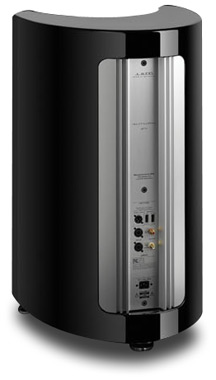 Perhaps most impressive is the
heavy-lifting part of the hardware. JL Audio manufactures its own drivers, and the ones in
the Gotham are a sight to behold. The version of their W7 made specifically for the Gotham
has a larger magnet structure than the one used in cars, and even differs from the version
in JLA’s Fathom subs. JLA claims that this driver’s excursion extends a full
4" from peak to peak. The cabinet housing these monsters is molded from fiberglass
with internal braces built into the mold -- JLA found that MDF was simply not strong
enough. JLA also makes their own power amplifiers; the 3800W class-D unit used in the
Gotham g213 includes an absolutely massive toroidal power transformer.
Perhaps most impressive is the
heavy-lifting part of the hardware. JL Audio manufactures its own drivers, and the ones in
the Gotham are a sight to behold. The version of their W7 made specifically for the Gotham
has a larger magnet structure than the one used in cars, and even differs from the version
in JLA’s Fathom subs. JLA claims that this driver’s excursion extends a full
4" from peak to peak. The cabinet housing these monsters is molded from fiberglass
with internal braces built into the mold -- JLA found that MDF was simply not strong
enough. JLA also makes their own power amplifiers; the 3800W class-D unit used in the
Gotham g213 includes an absolutely massive toroidal power transformer.